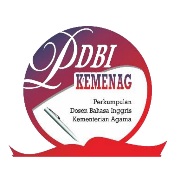Investigating EFL Students’ Self-Efficacy on the Use of QuillBot Paraphrasing Tool in Academic Writing
Abstract
The present study aimed to investigate the self-efficacy of EFL students regarding their use of the QuillBot paraphrasing tool in academic writing. A qualitative research method was employed, and data were gathered through interviews. The participants consisted of four EFL students who were currently in the process of writing their theses and utilizing the QuillBot paraphrasing tool. Data analysis was conducted using NVIVO thematic analysis.The findings indicated that EFL students' self-efficacy in utilizing the QuillBot paraphrasing tool was not satisfactory. This lack of self-efficacy was influenced by various factors, including behavioral, social, and personal aspects. Among these factors, behavioral elements had the most significant impact as they directly affected the students' competence in academic writing. The participants' belief in their own academic writing abilities was undermined by behavioral factors, as they experienced difficulties in vocabulary and grammar usage. Furthermore, the study revealed that the social environment played a crucial role in enhancing EFL students' self-efficacy. Specifically, the support and encouragement received from lecturers and classmates positively influenced the participants' self-belief and confidence in utilizing the QuillBot paraphrasing tool. In conclusion, this research suggests that EFL students' self-efficacy in using the QuillBot paraphrasing tool for academic writing can be improved by addressing behavioral challenges and fostering a supportive social environment.
Keywords
Full Text:
PDFReferences
Adams, W. C. (2015). Conducting Semi-Structured Interviews. In Handbook of Practical Program Evaluation: Fourth Edition (pp. 492–505). Wiley Blackwell. https://doi.org/10.1002/9781119171386.ch19
Aldabbus, S., & Almansouri, E. (2022). Academic Writing Difficulties Encountered by University EFL Learners. British Journal of English Linguistics, 10(3), 1 – 10. https://www.eajournals.org/
Almaiah, M. A. (2020). Thematic Analysis for Classifying the Main Challenges and Factors Influencing the Successful Implementation of E-learning System Using NVivo. International Journal of Advanced Trends in Computer Science and Engineering, 9(1), 142–152. https://doi.org/10.30534/ijatcse/2020/22912020
Bailey, S. (2018). Academic writing A Handbook for International Students. Routledge.
Bailey, S. (2003). Academic writing : a practical guide for students. Nelson Thornes Ltd.
Bakla, A., & Karakaş, A. (2022). Technology and strategy use in academic writing: Native, native-like versus non-native speakers of English. Iberica, 2022(44), 285–314. https://doi.org/10.17398/2340-2784.44.285
Braun, V., & Clarke, V. (2006). Using thematic analysis in psychology. Qualitative Research in Psychology, 3(2), 77 – 101.
Cennetkuşu, N. (2017). International students ‟ challenges in academic writing : A case study from a. Journal of Language and Linguistic Studies, 13(2), 309–323.
Dharma, A. D. D. (2018). Students’ Self-Efficacy: A Case Study on the First Semester Student of English Education at Jambi University. Universitas Jambi
Diaz, J. C. T, Duart, J. M., Carrión, P. V. T., & Gutierrez, I. M. (2021). Plagiarism and use of technology by high school students. Campus Virtuales, 10(2), 175–184.
Fitria, T. N. (2021). QuillBot as an online tool: Students’ alternative in paraphrasing and rewriting of English writing. Englisia: Journal of Language, Education, and Humanities, 9(1), 183 – 196. https://doi.org/10.22373/ej.v9i1.10233
Fitria, T. N. (2022). Avoiding Plagiarism of Students’ Scientific Writing by Using the QuillBot Paraphraser. Elsya : Journal of English Language Studies 4(3), 252–262. https://doi.org/10.31849/elsya.v4i2.9917
Fitriah, P., Bunau, E., Rahmani, E. F., Apriliaswati, R., & Rosnija, E. (2023). Effectiveness of Learn English Vocabulary Application in Enriching Students’ Vocabulary Learning. Journal of Scientific Research, Education, and Technology (JSRET), 2(2), 849–859. https://doi.org/10.58526/jsret.v2i2.166
Flammer, A. (2001). Self-Efficacy. International Encyclopedia of the Social and Behavioral Sciences.
Geyte, E. V. (2013). Writing : learn to write better academic essays. HarperCollins Publisher.
Guest, G., MacQueen, K. M., & Namey, E. E. (2012). Applied Thematic Analysis. Routledge.
Han, Y., Zhao, S., & Ng, L. L. (2021). How Technology Tools Impact Writing Performance, Lexical Complexity, and Perceived Self-Regulated Learning Strategies in EFL Academic Writing: A Comparative Study. Frontiers in Psychology, 12, 1–18. https://doi.org/10.3389/fpsyg.2021.752793
Harmer, J. (2007). The Practice of English Language Teaching. Pearson Longman ELT.
Hayat, A. A., Shateri, K., Amini, M., & Shokrpour, N. (2020). Relationships between academic self-efficacy, learning-related emotions, and metacognitive learning strategies with academic performance in medical students: A structural equation model. BMC Medical Education, 20(1), 1–11. https://doi.org/10.1186/s12909-020-01995-9
Hiếu, B. V., Huy, H. M., & Hằng, C. T. T. (2022). ÁP DỤNG ỨNG DỤNG QUILLBOT NHẰM CẢI THIỆN KỸ NĂNG TÁI DIỄN ĐẠT TRONG VIẾT BÀI LUẬN HỌC THUẬT ĐỐI VỚI SINH VIÊN CHUYÊN NGÀNH NGÔN NGỮ ANH, TRƯỜNG NGOẠI NGỮ, ĐẠI HỌC THÁI NGUYÊN. TNU Journal of Science and Technology, 227(13), 116–124. https://doi.org/10.34238/tnu-jst.6717
Honicke, T., & Broadbent, J. (2016). The influence of academic self-efficacy on academic performance: A systematic review. Educational Research Review, 17, 63–84. https://doi.org/10.1016/j.edurev.2015.11.002
Ismail, Sunubi, A. H., Halidin, A., Amzah, Nanning, & Kaharuddin. (2020). Paraphrasing technique to develop skill for english writing among indonesian college students of English. Systematic Reviews in Pharmacy, 11(11), 291–297. https://doi.org/10.31838/srp.2020.11.43
Kurniati, E. Y., & Fithriani, R. (2022). Post-Graduate Students’ Perceptions of Quillbot Utilization in English Academic Writing Class. Journal of English Language Teaching and Linguistics, 7(3), 437. https://doi.org/10.21462/jeltl.v7i3.852
Mardhiyyah, S. A, Latief, M. A., & Masduqi, H. (2021). Enhancing the Students’ Learning Motivation by Using Instructional Media for Thailand’s Municipal School. Pedagogy : Journal of English Language Teaching, 9(1), 76 – 91. https://doi.org/10.32332/joelt.v9i1.3131
Mustafa, A., Arbab, A. N, & Sayed, A. A. E. (2022). Difficulties in Academic Writing in English as a Second/Foreign Language from the Perspective of Undergraduate Students in Higher Education Institutions in Oman. Arab World English Journal, 13(3), 41–53. https://doi.org/10.24093/awej/vol13no3.3
Nurmayanti, N., & Suryadi, S. (2023). The Effectiveness Of Using Quillbot In Improving Writing For Students Of English Education Study Program. Jurnal Teknologi Pendidikan : Jurnal Penelitian Dan Pengembangan Pembelajaran, 8(1), 32 – 40. https://doi.org/10.33394/jtp.v8i1.6392
Oshima, A., & Hogue, A. (2007). Introduction to academic English. Pearson/Longman.
Ovilia, R., Addinna, A., & Oktoviandry, R. (2022). Students’ Paraphrasing Ability in Academic Writing : Techniques and Challenges. Komposisi: Jurnal Pendidikan Bahasa, Sastra, dan Seni, 23(2), 141 – 151.
Rosyada, A., & Sundari, H. (2021). Learning from home environment: Academic writing course for efl undergraduates through google classroom application. Studies in English Language and Education, 8(2), 710–725. https://doi.org/10.24815/siele.v8i2.18374
Saefudin, W., Sriwiyanti, S., & Yusoff, S. H. M. (2021). Role of Social Support Toward Student Academic Self-Efficacy in Online Learning During Pandemic. Jurnal Tatsqif, 19(2), 133–154. https://doi.org/10.20414/jtq.v19i2.4221
Sajjad, I., Sarwat, S., Imran, M., & Khuram Shahzad, S. (2021). Examining The Academic Writing Challenges Faced By University Students In Kfueit. PalArch’s Journal of Archaeology of Egypt / Egyptology, 18(10), 1759–1777.
Saugadi., & Sari, N. I. P. (2020). The Role of Teachers in Increasing Student Motivation of Students in Sman 2 Tolitoli During the Pandemic Covid-19. Jurnal Madako Education, 6(2), 165–171.
Schunk, D. H. (1995). Self-Efficacy and Education and Instruction. 281–303. https://doi.org/10.1007/978-1-4419-6868-5_10
Schunk, D. H., & DiBenedetto, M. K. (2021). Self-efficacy and human motivation. In Advances in Motivation Science (1st ed., Vol. 8). Elsevier Inc. https://doi.org/10.1016/bs.adms.2020.10.001
Si, P. (2019). A Study of the Differences between EFL and ESL for English Classroom Teaching in China. IRA International Journal of Education and Multidisciplinary Studies, 15(1), 32 – 35. https://doi.org/10.21013/jems.v15.n1.p4
Syahnaz, M., & Fithriani, R. (2023). Utilizing Artificial Intelligence-based Paraphrasing Tool in EFL Writing Class: A Focus on Indonesian University Students’ Perceptions. Scope : Journal of English Language Teaching, 7(2), 210 – 218. https://doi.org/10.30998/scope.v7i2.14882
Tabernero, C., & Hernández, B. (2011). Self-efficacy and intrinsic motivation guiding environmental behavior. Environment and Behavior, 43(5), 658–675. https://doi.org/10.1177/0013916510379759
Tardy, C. M (2010). Writing for the World: Wikipedia as an Introduction to Academic Writing. English Teaching Forum, 1, 12 – 27.
Villegas-Puyod, J., Sharma, S., Ajah, S., Chaisanrit, M., & Skuldee, B. (2020). The Role of Teacher Support, Classmate Support, and Self-efficacy in Reducing Speaking Anxiety among University Students Using English as a Foreign Language. Human Behavior Development & Society, 21(3), 59–68. http://simsrad.net.ocs.mq.edu.au/login?url=https://search.ebscohost.com/login.aspx?direct=true&db=aph&AN=146377304&site=ehost-live
Wang, P. (2017). A Comparative Study of EFL/ESL Academic Writing among Mandarin Chinese Speakers on Coherence in Discourse: Cross-cultural and Language Development Effects. University of York.
Wentzel, K., & Wigfield, A. (2016). Handbook of Motivation at School. Handbook of Motivation at School. https://doi.org/10.4324/9781315773384
Zainal, Z. (2007). Case study as a research method. Jurnal Kemanusiaan, 9, 1 – 6.
DOI: http://dx.doi.org/10.29240/ef.v8i1%20May.8831
Refbacks
- There are currently no refbacks.
Copyright (c) 2024 Agis Andriani, Asri Siti Fatimah, Sylvia Arini Permatasari

This work is licensed under a Creative Commons Attribution-NonCommercial-ShareAlike 4.0 International License.
INDEXED BY:
 This work is licensed under a Creative Commons Attribution-NonCommercial-ShareAlike 4.0 International License
This work is licensed under a Creative Commons Attribution-NonCommercial-ShareAlike 4.0 International License
@ ENGLISH FRANCA : Academic Journal of English Language and Education
Jl. Dr. AK Gani No 1 Dusun Curup, Rejang Lebong Regency, Bengkulu Province, Indonesia, 39119.
Dr. Eka Apriani, M.Pd., email: efranca@iaincurup.ac.id, eka.apriani@iaincurup.ac.id.





.png)












